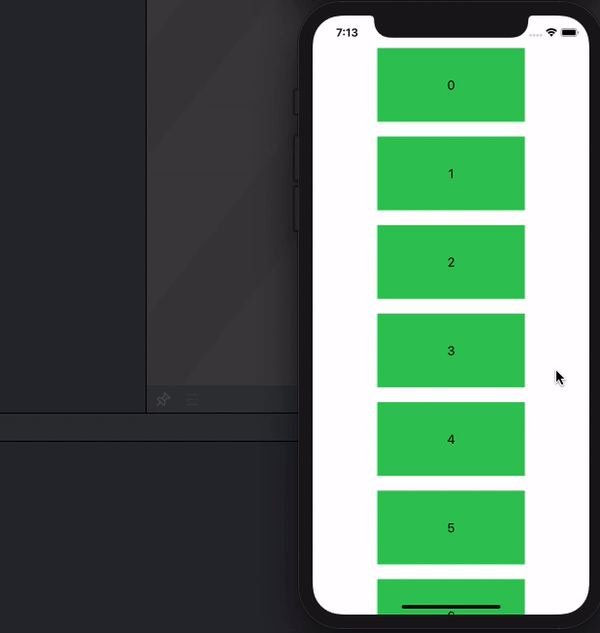I need to find out the exact moment when my ScrollView stops moving.
Is that possible with SwiftUI?
Here would be an equivalent for UIScrollView.
I have no idea after thinking a lot about it...
A sample project to test things out:
struct ContentView: View {
var body: some View {
ScrollView {
VStack(spacing: 20) {
ForEach(0...100, id: \.self) { i in
Rectangle()
.frame(width: 200, height: 100)
.foregroundColor(.green)
.overlay(Text("\(i)"))
}
}
.frame(maxWidth: .infinity)
}
}
}
Thanks!
Here is a demo of possible approach - use publisher with changed scrolled content coordinates with debounce, so event reported only after coordinates stopped changing.
Tested with Xcode 12.1 / iOS 14.1
UPDATE: verified as worked with Xcode 13.3 / iOS 15.4
Note: you can play with debounce period to tune it for your needs.

import Combine
struct ContentView: View {
let detector: CurrentValueSubject<CGFloat, Never>
let publisher: AnyPublisher<CGFloat, Never>
init() {
let detector = CurrentValueSubject<CGFloat, Never>(0)
self.publisher = detector
.debounce(for: .seconds(0.2), scheduler: DispatchQueue.main)
.dropFirst()
.eraseToAnyPublisher()
self.detector = detector
}
var body: some View {
ScrollView {
VStack(spacing: 20) {
ForEach(0...100, id: \.self) { i in
Rectangle()
.frame(width: 200, height: 100)
.foregroundColor(.green)
.overlay(Text("\(i)"))
}
}
.frame(maxWidth: .infinity)
.background(GeometryReader {
Color.clear.preference(key: ViewOffsetKey.self,
value: -$0.frame(in: .named("scroll")).origin.y)
})
.onPreferenceChange(ViewOffsetKey.self) { detector.send($0) }
}.coordinateSpace(name: "scroll")
.onReceive(publisher) {
print("Stopped on: \($0)")
}
}
}
struct ViewOffsetKey: PreferenceKey {
typealias Value = CGFloat
static var defaultValue = CGFloat.zero
static func reduce(value: inout Value, nextValue: () -> Value) {
value += nextValue()
}
}
For me the publisher also didn't fire when implementing Asperi's answer into a more complicated SwiftUI view. To fix it I created a StateObject with a published variable set with a certain debounce time.
To my best of knowledge, this is what happens: the offset of the scrollView is written to a publisher (currentOffset) which then handles it with a debounce. When the value gets passed along after the debounce (which means scrolling has stopped) it's assigned to another publisher (offsetAtScrollEnd), which the view (ScrollViewTest) receives.
import SwiftUI
import Combine
struct ScrollViewTest: View {
@StateObject var scrollViewHelper = ScrollViewHelper()
var body: some View {
ScrollView {
ZStack {
VStack(spacing: 20) {
ForEach(0...100, id: \.self) { i in
Rectangle()
.frame(width: 200, height: 100)
.foregroundColor(.green)
.overlay(Text("\(i)"))
}
}
.frame(maxWidth: .infinity)
GeometryReader {
let offset = -$0.frame(in: .named("scroll")).minY
Color.clear.preference(key: ViewOffsetKey.self, value: offset)
}
}
}.coordinateSpace(name: "scroll")
.onPreferenceChange(ViewOffsetKey.self) {
scrollViewHelper.currentOffset = $0
}.onReceive(scrollViewHelper.$offsetAtScrollEnd) {
print($0)
}
}
}
class ScrollViewHelper: ObservableObject {
@Published var currentOffset: CGFloat = 0
@Published var offsetAtScrollEnd: CGFloat = 0
private var cancellable: AnyCancellable?
init() {
cancellable = AnyCancellable($currentOffset
.debounce(for: 0.2, scheduler: DispatchQueue.main)
.dropFirst()
.assign(to: \.offsetAtScrollEnd, on: self))
}
}
struct ViewOffsetKey: PreferenceKey {
static var defaultValue = CGFloat.zero
static func reduce(value: inout CGFloat, nextValue: () -> CGFloat) {
value += nextValue()
}
}
If you love us? You can donate to us via Paypal or buy me a coffee so we can maintain and grow! Thank you!
Donate Us With